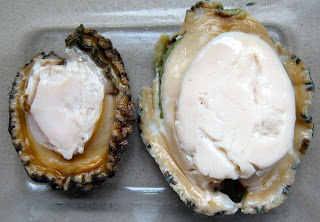Five days in Singapore turned out to be a lively multicultural street food extravaganza. We tried snacks from China, Malaysia, India and elsewhere, along with those that were uniquely Singaporean.
'Uniquely' Singaporean - that's a strange one. A tiny collection of islands on the southern tip of Malaysia, Singapore seemed to me to be a smorgasbord of cultures. For such a small country it boasts four national languages - English, Chinese, Malay and Tamil. And each of these have themselves been morphed into a new, singularly Singaporean form. The place is a multi-lingual mind bender - my daily conversations with everyone from taxi drivers to market stall holders veered wildly from sing-song English to accented Cantonese to modified Mandarin. Trying to understand the locals while not falling into various linguistic potholes created by localised slang and tonal differences was challenging, but also fun in a 'hey look at me, I'm speaking three languages at once!' kind of way.
The food unsurprisingly reflected this crazy blend of cultures. I was bowled over by the huge variety of 'hawker stalls' and how much locals know and love to share with others their favourite places and dishes. Here's some examples:
Oyster omelette at Singapore Food Trail, Singapore Flyer. Bit greasy, and sea salty, and eggy. Hm.
Carrot cake, made from daikon, chopped and fried in an omelette, unlike the cakes studded with Chinese sausage and spring onion eaten in Chinese dim sum restaurants. I prefer my more familiar dim sum version, but this was interesting to try.
Fried oysters stall at Singapore Food Trail.
Bak Kut Teh - a herbal soup with soft pork ribs and soft, slow cooked garlic. Almost ginseng-like in flavour, although it's not one of the ingredients. A lovely, soothing broth that feels like it's good for you.
The Bak Kut Teh soup stall, also at Singapore Flyer.
Geyland Serai wet market - so clean!!
Not a bit of mess anywhere.
The famous Sinar Pagi Nasi Padang stall at Geyland Serai market, which always has a queue.
Sotong Hitam - Squid stewed in a black ink sauce - soft, spicy, rich and full of deep chilli undertones. One of the best things I ate that week. Really moreish and comforting.
The full Indonesian - nasi padang - rice with my choice of fried beef lungs (paru belado), quails eggs in sambal, young tapioca leaves in coconut milk, fried chicken (arum bumbo) topped with fried chicken floss, pickles (atchar) and of course plenty of chilli sauce.
Turtle soup at the Old Airport Road food centre, an enormous, buzzing hive of hungry visitors and frenetic stall chefs. Considered to be a tonic or healing soup, it uses the gelatinous 'skin' under the shell, the legs and the innards. Despite my initial doubts, having never tried turtle before, I was intrigued to find that what I have heard - that turtle is incredibly tasty, seems to be true. The soup was really, seriously delicious. The flavour was complex and almost spicy in its herbal-ness. Again I thought of ginseng, but according to the stallholder there is nothing else in the soup except turtle, red dates and goji berries. If this is true then the taste of turtle is something I would love to learn more about...will have to try some other versions.
Delicious, lightly sweetened beancurd from Lao Ban Soya Bean Curd, which has been so successful they now have four or five outlets and a website. Their beancurd has a lovely, delicate texture. It is not quite the same as Chinese 'flower' bean curd, with its ginger and rock sugar syrup dressing, but it was very refreshing and a welcome palate cleanser.
The ladies at Freshly Made Chee Cheong Fun in action.
Scallop and prawn cheong fun - not bad. The steamed rice rolls are notoriously different to cook as they can easily overcook. The rolls should be steamed until they are soft and slippery, while each layer is still distinct - so you could unravel the roll if you wanted to. Steamed a moment more and they will overcook, melting into a stodgy mush.
Big prawn noodle soup from Whitley Road Big Prawn Noodle - impressively rich and aromatic prawn broth, with bouncy firm noodles - deeply satisfying.
Sliced pig's intestines and trotters from Blanco Court Food Centre, in an offaly gravy and served with a chilli and tamarind sauce for dipping. The sauce made the dish, balancing soft earthy textures with hot spicy tastes.
Roast duck, barbecued pork (char siu) and roast pork belly at Chinatown Complex. The char siu was especially tasty - soft meat, sweet honeyed glaze and chewy charred edges.
Fish slice and fish ball soup with minced pork. The fish balls were handmade - not bad, if more suited to Asian palates and their love of textures.
Satay street outside Lau Pa Sat. The indoor food stalls are busy by day serving central business district workers, where the building is located. Outside the charcoal grills fire up after dark and Singaporeans crowd in to drink beer and dunk meat into peanut and chilli sauces.
Lau Pa Sat - deserted at night.
Charcoal grilled prawns, chicken and beef - smoky, sweet and moreish.
Erm, not exactly street food! A farewell dinner at Waku Ghin - Australian chef Wakuda Tetsuya's Singaporean outpost and an extravagant treat. This dish features two of my all time favourite things in the world (and some deep sea raw sweet shrimp) - sea urchin and Oscietra caviar. Oh. Wow.
Fresh wasabi root grated on shark's skin. Now I want to own a shark skin grater. Oh dear.
And finally, two little rolls of fatty Wagyu beef, seared on the outside, served with wasabi and lightly deep fried garlic chips.
Bye bye Singapore - what an awesome, awesome trip.
How to Make a Great Vegetarian Poke Bowl
3 days ago





















































